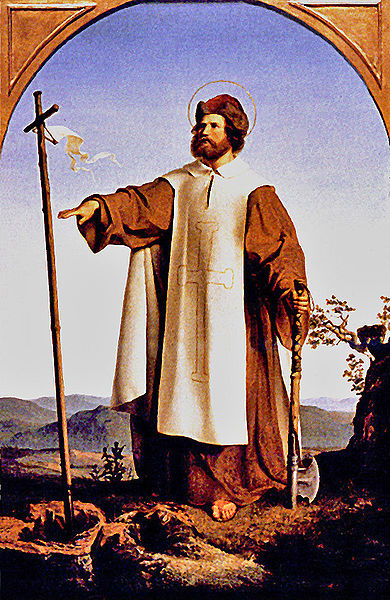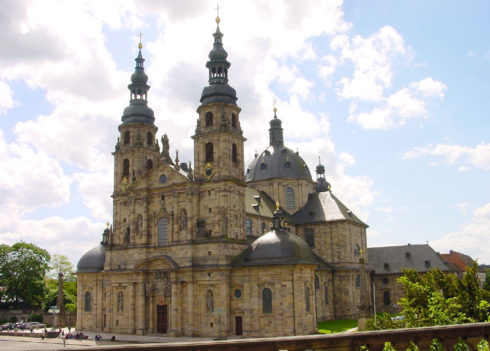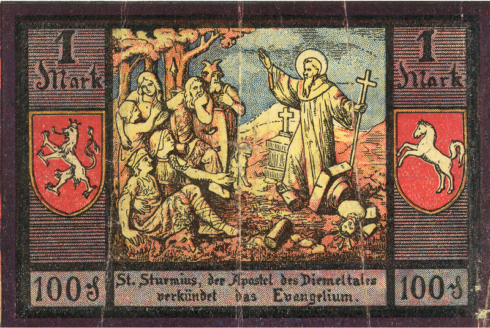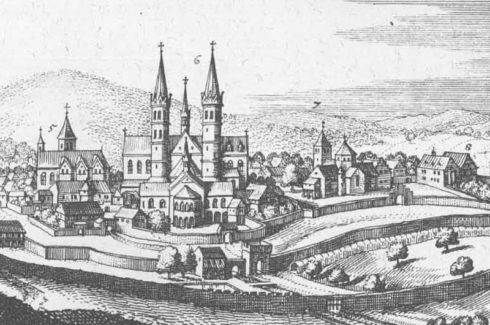To systematize the work of evangelizing Germany, St. Boniface organized a hierarchy on the usual ecclesiastical basis; in Bavaria the Dioceses of Salzburg, Freising, Ratisbon, and Passau; in Franconia and Thuringia, Würzburg, Eichstätt, Buraburg near Fritzlar, and Erfurt. To facilitate missionary work farther north, especially among the Saxons, he sought a suitable spot for the location of a monastery. He chose for this mission St. Sturmius, who, after journeying far and wide, found an appropriate place in the great forest of Buchonia, in the district of Grabfeld on the Fulda. Boniface sanctioned this choice of a location, and petitioned Carloman, to whom the country round about belonged, to grant him the site for a monastery. Carloman yielded to the saint’s request, and also induced the Frankish nobles who had estates in the vicinity to bestow a part of them on the Church. On 12 March, 744, St. Sturmius took solemn possession of the land, and raised the cross. The wilderness was soon cleared, and the erection of the monastery and church, the latter dedicated to the Most Holy Redeemer, begun under the personnel direction of St. Boniface. He appointed St. Sturmius first abbot of the new foundation, which he intended to surpass in greatness all existing monasteries of Germany, and to be a nursery for priests. The rule was modelled on that of the Abbey of Monte Cassino, as Sturmius himself had gone to Italy (748) for the express purpose of becoming familiar with it. To secure absolute autonomy for the new abbey, Boniface obtained from Pope Zachary a privilege, dated 4 November, 751, placing it immediately under the Holy See, and removing it from all episcopal jurisdiction. The authenticity of this document has frequently been called into question, but on the whole it is considered as well established. (For further details see Tangl in “Mitteilungen des Instituts für österreichische Geschichtsforschung”, 1899; and B. Sepp, “Die Fuldaer Privilegien Frage”, Ratisbon, 1908.) In 753 Pepin gave the royal sanction to this exemption from episcopal jurisdiction. Boniface showed his love for Fulda when he charged that his remains should be laid to rest there.
Under the prudent administration of St. Sturmius (d. 779), the monastery soon rose to greater splendour; from an early period the tomb of St. Boniface made it a national sanctuary for Christian Germany. Great success crowned the agricultural work of the monks, and small colonies which were established in different places gradually became the centres of villages and civil communities. Soon Fulda was the mother-house of a number of smaller monasteries, which were later administered by provosts under the superiorship of the abbot. The gifts of German princes, nobles, and private individuals increased the landed possessions of the abbey so rapidly that they soon extended over distant parts of Germany; there were estates in Thuringia, Saxony, Hesse, Bavaria, Lorraine, Swabia: possessions along the Rhine, in East Frisia, and even at Rome (the church of Sant’ Andrea). Even in artistic and literary lines Fulda rose to great importance. On the site of the first church, which had been artistically decorated by Sturmius, there rose under Abbots Baugulf (779-802), Ratgar (802-17), Eigil (818-22), and Rabanus Maurus (822-42) a magnificent edifice which roused the admiration of contemporaries, and even of posterity, and exerted a lasting influence on architectural and artistic activity in distant places. In addition to architecture, sculpture and painting were zealously cultivated. The monastic school established by Sturmius began to flourish during the time of Charlemagne and Alcuin, and, under Rabanus Maurus, particularly, was the chief nursery of civilization and learning in Germany, and became celebrated throughout Europe. It was open not only to theological students, but also to young men desiring to embrace secular careers. The curriculum embraced the subjects usually taught during the Middle Ages: the seven liberal arts (grammar, rhetoric, dialectics, arithmetic, geometry, physics, and astronomy), the different branches of theology, and the German language. Among the most renowned pupils of this school were: Rabanus Maurus, Walafried Strabo, Servatus Lupus, Otfried of Weissenburg, Rudolfus Fuldensis, Williram, Probus, and Meginhard; among the laity: Einhard, Bernhard, King of Italy, and Ulrich von Hutten. Rabanus also founded a library to familiarize the Germans with religious and classical literature, and the zeal of the monks soon produced rich treasures of valuable manuscripts. Unfortunately the greater part of this library disappeared during the looting of the abbey by the Hessians in 1631, and has not since been discovered.
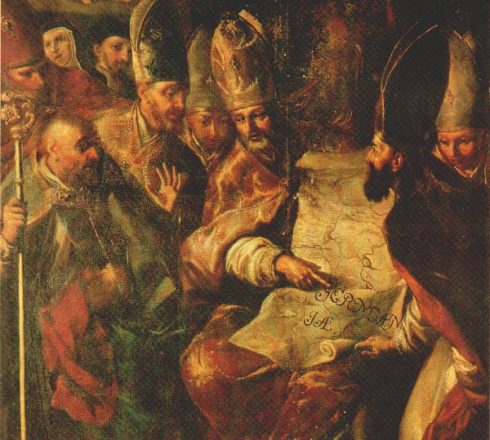
Painting of St. Boniface establishing the four ancient Bavarian dioceses, pointing them out to the various Bishops and Abbot.
Gradually the monastery rose to a commanding position in the German Empire. From 968 the abbot was primate of all the Benedictine monasteries of Germany and Gaul; from the time of Otto I, arch-chancellor of the empress, whom he crowned jointly with the Elector of Mainz; from the twelfth century he was a prince of the empire; from 1184 had the privilege of sitting at the left of the emperor; and from 1360 the imperial banner was borne before him by a knight. This glory, however, was not wholly without shadows. The monastic discipline was relaxed to such a degree that Abbot Marquard (1150-65) undertook to carry out a reform by introducing the regulations in force at Hirsau (Consuetudines Hirsaugienses). The importance of the school as a centre of learning also declined. The great wealth of the abbey in landed possessions, tithes, revenues, and regalia drew an increasing number of nobles to the monastery. By the twelfth century the monks of noble birth had monopolized the seats of the chapter and, in the course of time, practically all the important offices of the abbey itself, as well as the provostships of the dependent houses, were held by members of the German nobility. The difficulty of administering the vast landed possessions caused the abbots to grant certain sections in fief, which eventually resulted in great losses to the abbey; for the feudatories frequently turned their positions to their own personal interests, and sought to convert the fiefs into private property. One of the most notable illustrations of the greed of these monastic stewards is shown by the action of Count Johann von Ziegenhain in the fourteenth century, who, in an insurrection of the burgers of the city of Fulda against Abbot Heinrich VI von Hohenberg (1315-53), headed an attack on the monastery. Not infrequently, too, the obligations of the abbots as princes of the empire, and the demands made upon them by the state proved most detrimental to the interests of the monastery and its inmates. In 1294, on application of the convent, the pope enjoined a separation of the abbatial and the conventual tables, which was put into effect in 1300 under Abbot Heinrich V von Weilnau (1288-1313) (cf. Rübsam, “Heinrich V. von Weilnau, Fürstabt von Fulda”, Fulda, 1879). Imperial capitulations, of which there are records as early as the time of Heinrich VII von Kranlucken (1353-72), especially those of Johann I von Merlau (1395-1440), the “Old Statutes of 1395”, restricted to a considerable degree the authority of the abbot over the convent, and raised correspondingly the independent status of that institution. In the mother-house the dean eventually replaced the abbot for all practical purposes. For centuries the chapter preserved this independence, which involved the almost complete exclusion of the abbot from the ecclesiastical organization of his monastery.
At a comparatively early date the teachings of the Reformers found access to the chapter of Fulda, with which, in 1513, the Abbey of Hersfeld had been united; and Abbot Johannes III von Henneberg (1521-41) was forced to consent to a decree of reform favouring the spread of the new doctrines. The zealous Abbot Balthasar von Dermbach (1570-1606) proved an earnest restorer of discipline in the chapter, vigorously inaugurating the work of the Counter-Reformation. Banished by the members of the chapter and their colleagues in 1576, he was unable to return to his abbey until 1602, great progress having been made meanwhile by the imperial administrators in restoring the Catholic Faith. The foundation of a Jesuit college in 1571 was the signal for the reflorescence of the school, which had sunk to comparative insignificance. In addition to the Jesuit gymnasium, Gregory XIII founded (1584) a papal seminary, which he placed under the direction of the Jesuits. Both of these institutions have contributed largely to the maintenance and spread of the Catholic Faith in Germany. A similar zeal for reform was displayed by Balthasar’s second successor, Johann Bernhard Schenk von Schweinsberg (1623-32), whose exertions, together with the decrees of several papal visitors, particularly Pietro Luigi Caraffa (1627), restored to the abbot a certain measure of his proper authority, over against that of the chapter and the professors of noble birth. The decrees of reform issued by Caraffa, against which the provosts rebelled after the nuncio’s departure, were repeatedly confirmed by the Holy See. The capitulars and provosts of noble birth still retained the privilege of admitting into the chapter only such as could show a certain number of noble ancestors, and this prerogative received papal confirmation in 1731. During the Thirty Years War the chapter was again menaced; in 1631, Landgrave Wilhelm V of Hesse, by virtue of a treaty with Gustavus Adolphus, received the abbey in fief to Sweden, and sought gradually to make Protestantism predominant. After the battle of Nördlingen, however, he no longer had power over Fulda. When the turmoil of the war had ceased, the abbey experienced a period of peace and prosperity. In 1732 the Jesuit and Benedictine schools were united, enlarged, and converted into a university. Benedict XIV raised the abbey to the rank of a bishopric (5 Oct., 1752), with the retention of its monastic organization. The first prince-bishop was Amand von Buseck (1737-56), the collegiate chapter of one dean and fourteen capitulars being now the cathedral chapter.
 By the Imperial Delegates’ Enactment (Reichsdeputationshauptschluss) of 1802 the abbey was secularized, and bestowed on the Prince of Orania as a secular principality; it embraced at this time forty sq. miles, with a population of 100,000. Under Napoleon, in 1809, it was ceded to the Grand Duchy of Frankfort; in 1815, to Hesse-Kassel, with which, in 1866, it passed to Prussia. The university was closed under the law of secularization, and the papal seminary was converted into an episcopal seminary. The last prince-bishop, Adalbert III von Harstall (1788-1802), died in 1814.
By the Imperial Delegates’ Enactment (Reichsdeputationshauptschluss) of 1802 the abbey was secularized, and bestowed on the Prince of Orania as a secular principality; it embraced at this time forty sq. miles, with a population of 100,000. Under Napoleon, in 1809, it was ceded to the Grand Duchy of Frankfort; in 1815, to Hesse-Kassel, with which, in 1866, it passed to Prussia. The university was closed under the law of secularization, and the papal seminary was converted into an episcopal seminary. The last prince-bishop, Adalbert III von Harstall (1788-1802), died in 1814.
In accordance with the Bulls “Provida solersque” of 1821 and “Ad dominici gregis custodiam” of 1827, the Diocese of Fulda was re-established in 1829, and made suffragan to the ecclesiastical province of the Upper Rhine, the first bishop being Johann Adam Rieger (1829-31).
In 1857 and 1871 the boundaries of the new diocese were so altered as to define the territory now embraced within it. It was seriously affected by the Kulturkampf, the see being vacant from 1873 to 1881, and the seminary closed between 1873 and 1886; some of the religious communities suppressed at that time have never been re-established.
BROUWER, Fuldensium antiquitates libri IV (Antwerp, 1612); SCHANNAT, Corpus traditionum Fuldensium (Leipzig, 1724); IDEM, Fuldischer Lehn-hof (Frankfort-on-the-Main, 1726); IDEM, Vindiciæ quorundam archivi Fuldensis diplomatum (Frankfort-on-the-Main, 1728); DRONKE, Traditiones et antiquitates Fuldenses (Kassel, 1844); IDEM, Codex diplomaticus Fuldensis (Kassel, 1850; index, 1862); ARND, Geschichte des Hochstifts Fulda (Frankfort, 1862); GEGENBAUER, Das Kloster Fulda im Karolingerzeitalter (2 vols., 1871, 1873); KOMP, Die zweite Schule Fuldas und das päpstliches Seminar (Fulda, 1877); IDEM in Kirchenlex., s. v.; LOTZ, Die Hochschule zu Fulda, in Hessenland, XII (1898); HEYDENREICH, Das älteste Fuldaer Cartular (Leipzig, 1899); RICHTER, Die ersten Anfänge der Bau- und Kunsttätigkeit des Klosters Fulda (Fulda, 1900); IDEM, Quellen und Abhandlungen zur Geschichte der Abtei und der Diözese Fulda, I-III (Fulda, 1904-07); Schematismus der Diözese Fulda (Fulda, 1904; new ed., 1909); Festgabe zum Bonifatiusjubilæum, 1905 (Fulda, 1905); a collection of original documents relating to Fulda is in the course of preparation.
JOSEPH LINS (Catholic Encyclopedia)
